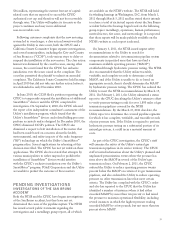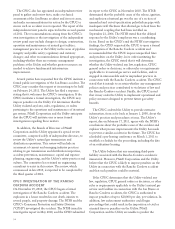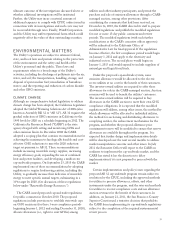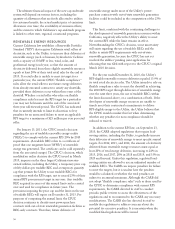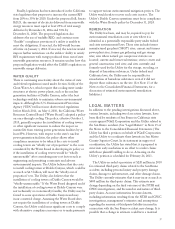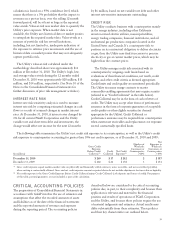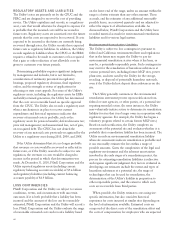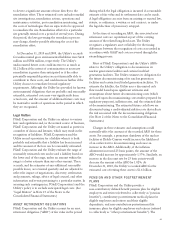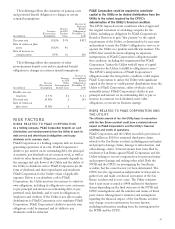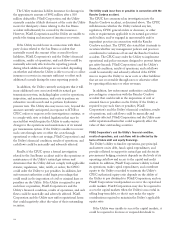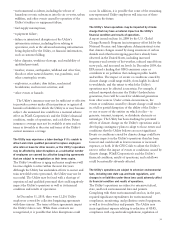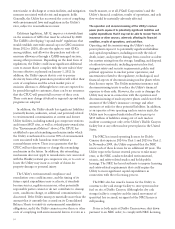PG&E 2010 Annual Report Download - page 46
Download and view the complete annual report
Please find page 46 of the 2010 PG&E annual report below. You can navigate through the pages in the report by either clicking on the pages listed below, or by using the keyword search tool below to find specific information within the annual report.measurement of costs and obligations to provide pension
benefits and other postretirement benefits are based on a
variety of factors, including the provisions of the plans,
employee demographics and various actuarial calculations,
assumptions, and accounting mechanisms. The
assumptions are updated annually and upon any interim
re-measurement of the plan obligations.
Actuarial assumptions used in determining pension
obligations include the discount rate, the average rate of
future compensation increases, and the expected return on
plan assets. Actuarial assumptions used in determining
other postretirement benefit obligations include the
discount rate, the expected return on plan assets, and the
health care cost trend rate. PG&E Corporation and the
Utility review these assumptions on an annual basis and
adjust them as necessary. While PG&E Corporation and
the Utility believe that the assumptions used are
appropriate, significant differences in actual experience,
plan changes or amendments, or significant changes in
assumptions may materially affect the recorded pension
and other postretirement benefit obligations and future
plan expenses.
Changes in benefit obligations associated with these
assumptions may not be recognized as costs on the
statement of income. Differences between actuarial
assumptions and actual plan results are deferred in
accumulated other comprehensive income (loss) and are
amortized into income only when the accumulated
differences exceed 10% of the greater of the projected
benefit obligation or the market value of the related plan
assets. If necessary, the excess is amortized over the average
remaining service period of active employees. As such,
benefit costs recorded in any period may not reflect the
actual level of cash benefits provided to plan participants.
PG&E Corporation’s and the Utility’s recorded pension
expense totaled $397 million in 2010, $458 million in
2009, and $169 million in 2008. PG&E Corporation and
the Utility recorded expense for other postretirement
benefits of $104 million in 2010, $94 million in 2009, and
$44 million in 2008.
PG&E Corporation and the Utility recognize the funded
status of their respective plans on their respective
Consolidated Balance Sheets with an offsetting entry to
accumulated other comprehensive income (loss), resulting
in no impact to their respective Consolidated Statements
of Income.
Since 1993, the CPUC has authorized the Utility to
recover the costs associated with its other postretirement
benefits based on the annual tax-deductible contributions
to the appropriate trusts. Regulatory adjustments have been
recorded in the Consolidated Statements of Income and
the Consolidated Balance Sheets of the Utility to reflect
the difference between Utility pension expense or income
for accounting purposes and Utility pension expense or
income for ratemaking, which is based on a funding
approach.
The differences between pension benefit costs
recognized in accordance with GAAP and amounts
recognized for ratemaking purposes are recorded as a
regulatory asset or liability as amounts are probable of
recovery from customers. Therefore, the difference is not
expected to impact net income in future periods. (See Note
3 of the Notes to the Consolidated Financial Statements.)
Pension and other postretirement benefit funds are held
in external trusts. Trust assets, including accumulated
earnings, must be used exclusively for pension and other
postretirement benefit payments. Consistent with the
trusts’ investment policies, assets are primarily invested in
equity securities and fixed income securities. (See Note 12
of the Notes to the Consolidated Financial Statements.)
PG&E Corporation and the Utility review recent cost
trends and projected future trends in establishing health
care cost trend rates. This evaluation suggests that current
rates of inflation are expected to continue in the near term.
In recognition of continued high inflation in health care
costs and given the design of PG&E Corporation’s plans,
the assumed health care cost trend rate for 2010 is 8%,
gradually decreasing to the ultimate trend rate of 5% in
2018.
Expected rates of return on plan assets were developed
by determining projected stock and bond returns and then
applying these returns to the target asset allocations of the
employee benefit trusts, resulting in a weighted average rate
of return on plan assets. Fixed income returns were
projected based on real maturity and credit spreads added
to a long-term inflation rate. Equity returns were estimated
based on estimates of dividend yield and real earnings
growth added to a long-term rate of inflation. For the
Utility’s defined benefit pension plan, the assumed return
of 6.6% compares to a ten-year actual return of 6.2%.
The rate used to discount pension benefits and other
benefits was based on a yield curve developed from market
data of approximately 600 Aa-grade non-callable bonds at
December 31, 2010. This yield curve has discount rates
that vary based on the duration of the obligations. The
estimated future cash flows for the pension and other
postretirement benefit obligations were matched to the
corresponding rates on the yield curve to derive a weighted
average discount rate.
42



